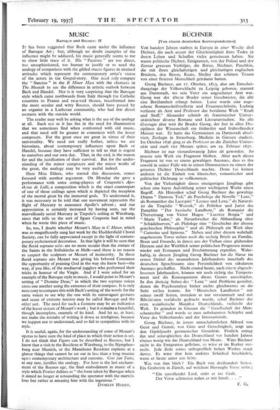Baroque and Rococo : II
MUSIC
IT has been suggested that Bach came under the influence of Baroque Art ; but, although no doubt examples of the influence might be adduced, his music generally seems to me to show little trace of it. His " Passions " are too direct, too unsophisticated, too human to justify or to need the analogy of comparison with the gilded stucco figures in strained attitudes which represent the contemporary artist's vision of the actors in the Gospel-story. One need only compare the " Sanctus " in the B Minor Mass with the choruses in The Messiah to see the difference in artistic outlook between Bach and Handel. Nor is it very surprising that the Baroque style which came northwards from Italy through the Catholic countries to France and returned thence, transformed into the more secular and witty Rococo, should have passed by an organist in a Lutheran community, who had few direct contacts with the outside world. IT has been suggested that Bach came under the influence of Baroque Art ; but, although no doubt examples of the influence might be adduced, his music generally seems to me to show little trace of it. His " Passions " are too direct, too unsophisticated, too human to justify or to need the analogy of comparison with the gilded stucco figures in strained attitudes which represent the contemporary artist's vision of the actors in the Gospel-story. One need only compare the " Sanctus " in the B Minor Mass with the choruses in The Messiah to see the difference in artistic outlook between Bach and Handel. Nor is it very surprising that the Baroque style which came northwards from Italy through the Catholic countries to France and returned thence, transformed into the more secular and witty Rococo, should have passed by an organist in a Lutheran community, who had few direct contacts with the outside world.
The reader may well be asking what is the use of the analogy at all. Such use as it has lies in the need for illumination that we sometimes find when confronted with old music, and that need will be greater in connexion with the lesser composers. For the great ones are great in virtue of their universality. We need not really bother, unless we are historians, about contemporary influences upon Bach or Handel, because they have sufficient to tell us that is cogent to ourselves and our own day. That, in the end, is the reason for and the justification of their survival. But for the under- standing of the minor composers and the minor works of the great, the analogy may be very useful indeed.
Here Miss Ehlers, who started this discussion, comes forward with another argument. On Monday she gave a performance with some string-players of Couperin's Apo- Wose de Lulli, a composition which is the exact counterpart
• of one of those ceilings upon which is depicted the reception of the mortal great by the immortal gods. To understand it, it was necessary to be told that one movement represents the flight of Mercury to announce Apollo's advent ; and our appreciation is certainly increased by having seen, say the marvellously aerial Mercury in Tiepolo's ceiling at Wiirzburg, since that tells us the sort of figure Couperin had in mind when- he wrote this piece of music.
So, too, I doubt whether Mozart's Mass in C Minor, which was so magnificently sung last week by the Huddersfield Choral Society, can be fully appreciated except in the light of contem- porary ecclesiastical decoration. In that light it will be seen that the florid soprano solo; are no more secular than the statues of the Saints in the Stiftskirche at Melk—and there is no reason to suspect the sculptors or Mozart of insincerity. In those florid soprano airs Mozart was giving his beloved Constanze the opportunity of praising God in the way she knew best—the way, if you like, of the mediaeval jugglers who performed their tricks in honour of the Virgin. And if I were asked for an example of the Baroque style in music, I would point to Mozart's setting of " Domine Deus," in which the two soprano voices cross one another using the extremes of their compass. It is only nece3sary to compare this with Bach's setting of the words for the same voices to see why the one with its extravagant gestures and sense of extreme tension may be called Baroque and the other not. The need for such a footnote may be an indication of the lesser stature of Mozart's work ; but it remains a beautiful, though incomplete, example of its kind. And let us, at least, not make the mistake of writing it down as irreligious, because we happen not to understand, and so fail to sympathise with its style.
It is useful, again, for the understanding of some of Mozart's operas to have seen the kind of place in which their action is set. I do not think that Figaro can be described as Rococo, but I know that a visit to the Residenz at Wiirzburg, to the Nymphen- burg near Munich, or the Mannheim Residenz explains at a glance things that cannot be set out in less than a long treatise upon contemporary architecture and customs. Cosi fan Tutte, at any rate, justifies the analogy. For here is the last enchant- ment of the Rococo age, the final embodiment in music of a style which Fowler defines as " the form taken by Baroque when it aimed no longer at astounding the spectator with the marvel- lous but rather at amusing him with the ingenious."
DYNELEV HUSSEY.














































 Previous page
Previous page